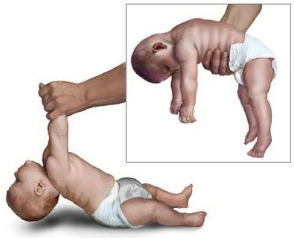Low Muscle Tone in Babies
Low muscle tone in babies, sometimes called hypotonia or “floppy baby,” is a condition that can affect your child’s development. If a doctor has mentioned low muscle tone, or you suspect low muscle tone, a physical therapist can help.
What is low muscle tone?
Tone is a description of a quality of a muscle, but it does not indicate strength. Muscle tone can be described as a muscle’s readiness to move at rest, or as a continuous partial contraction or “on” quality of a muscle. With typical muscle tone, muscles are partially active at rest to maintain postural control and to prepare for movement. For example, even when we are sitting on the couch, we are able to hold our heads up without thinking about it.

With low muscle tone, more of our muscle fibers are less active at rest. It is more difficult to maintain postural control and the body is not as ready for movement, especially fast movement. But that does not equate with muscle strength. Muscles with high tone are not necessarily strong and muscles with low tone are not necessarily weak. Having low tone does increase flexibility and can contribute to decreased strength (just as high tone sometimes has decreased flexibility and increase strength, with many exceptions.) A person with low tone will most likely not be able to engage in “explosive” movements such as needed in a sprinter. These athletes usually have high tone that is within normal limits. A person with low tone may do well in activities that require more flexibility, such as dance and yoga. In a baby with low muscle tone, their muscles are considered too relaxed and likely too flexible, which makes it more difficult to move and develop strength.
Signs of low muscle tone in babies
Your baby may demonstrate some or all of these symptoms as a result of low muscle tone.
In infancy (0-4 months)
- Poor head control- difficulty holding their head up when you are holding them, difficulty lifting their head off of their back when pulling to sit (head lag)
- Feels “floppy” or limbs feel loose
- May dislike tummy time
- Unable to lift head in tummy time
- Difficulty holding head in the center or at midline in multiple positions
In babies on the move (5-12 months)
- Difficulty rolling from back to tummy
- Difficulty pushing up onto straight arms in tummy time
- Poor endurance in tummy time
- Hypermobile joints (think legs really wide and out to the sides or frog leg position)
- Sitting posture characterized by rounded back, wide legs, hands on ground, and forward head
- W sitting
- Prefers sitting to moving
- Demonstrates “frog legs” or the ability to do the splits
- Late crawling (babies typically crawl between 8-10 months)
- Crawling with knees far apart or “frog legs”
- Flat feet in standing positions
Low muscle tone and strength
Muscle tone and strength are related but different things. While muscle tone is the muscle’s readiness to move, strength is the amount of force a muscle can generate. Typically, babies with low muscle tone also have weakness. However, a baby with low muscle tone can become strong with a little bit of help.
How a physical therapist can help
A physical therapist can assess if your baby has low muscle tone. Your physical therapist will determine the best course of action to help your baby get stronger and improve their endurance. Treatment may include exercises to improve head control, core strength, hip strength, and shoulder strength as well as developmental exercises to meet motor milestones. If you have concerns about low muscle tone, please call the pediatric specialists at Chicago Pediatric Therapy and Wellness Center for a physical therapy assessment. We can be reached at 773-687-9241 or info@cptwc.com.


